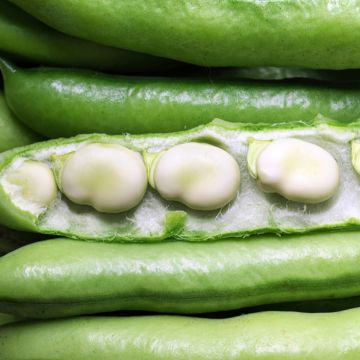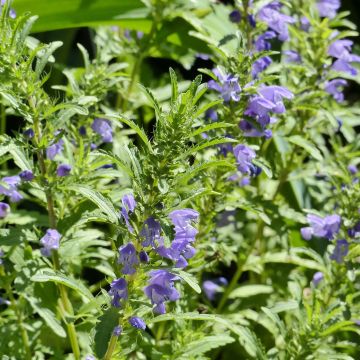

Broad bean Express


Broad bean Express
Broad bean Express
Vicia faba Express
Broad bean, fava bean, field bean, bell bean, English bean, horse bean, Windsor bean, pigeon bean, tic bean
I ate these vegetables once, then the plants died...
Annie M., 30/11/2020
Special offer!
Receive a €20 voucher for any order over €90 (excluding delivery costs, credit notes, and plastic-free options)!
1- Add your favorite plants to your cart.
2- Once you have reached €90, confirm your order (you can even choose the delivery date!).
3- As soon as your order is shipped, you will receive an email containing your voucher code, valid for 3 months (90 days).
Your voucher is unique and can only be used once, for any order with a minimum value of €20, excluding delivery costs.
Can be combined with other current offers, non-divisible and non-refundable.
Why not try an alternative variety in stock?
View all →This plant carries a 6 months recovery warranty
More information
We guarantee the quality of our plants for a full growing cycle, and will replace at our expense any plant that fails to recover under normal climatic and planting conditions.

Description
The Express Broad Bean is a fast-growing variety, with each plant producing up to 34 pods containing tender and tasty beans. It is a broad bean that freezes particularly well. The sowing period extends from February to June for a harvest from June to August.
The Broad Bean is a legume that belongs to the large Fabaceae family, like beans and peas. After falling somewhat out of fashion, it seems to be making a comeback in vegetable gardens. It is a vegetable that is worth rediscovering without hesitation, as its cultivation is easy.
Originally from Asia and the Middle East, the Broad Bean is widely grown around the world, both for its flavor and its nutritional qualities. Rich in energy nutrients, it is considered a starchy food. There are many varieties of Broad Beans, with varying pod sizes and grain colors: some are white, others are brown.
The Broad Bean can be consumed both raw and cooked. However, it is a dish that requires some effort, as preparing fresh Broad Beans takes time: you will need to shell them first, and then remove the second skin from each bean.
To enjoy them raw with a sprinkle of salt, like radishes, you should harvest them when they are young and tender, thus avoiding the second peeling. Generally, 1 kg of raw Broad Beans yields 250 g of peeled beans.
Cultivating Broad Beans is easy, and if your soil is rather poor, clayey, and moist, you can rejoice for once! Broad Beans are made for you. Indeed, like all Fabaceae, they are not demanding. And they thrive best in heavy and very fresh soils. They are also not very cold-sensitive and can be sown as early as February in most parts of France.
Harvest: Harvesting Broad Beans simply involves picking pods at different degrees of ripeness, depending on how you wish to consume them: raw, cooked, or dried.
Storage: Fresh Broad Beans can be stored for a few days in the vegetable compartment of your refrigerator. You can also dry them and store them at room temperature. Broad Beans also freeze very well.
The gardener's tip: Broad Beans are the preferred vegetable of black aphids. It is rare for them not to be attacked by a colony that usually descends massively on an entire row. To dislodge them without resorting to insecticides, you can spray water mixed with black soap (2 tablespoons per liter).
This year, in our garden, having read that their presence could promote fruiting, we let them be. Quickly, we noticed the presence of ladybugs. They were not numerous enough, of course, but the harvest was quite decent, even though, it must be admitted, the pods were black and rather sticky! In the end, we enjoyed them, and we believe that the ladybugs are now more numerous in the garden, as there is not a single aphid on our Nasturtiums.
Harvest
Plant habit
Foliage
Botanical data
Vicia
faba
Express
Fabaceae
Broad bean, fava bean, field bean, bell bean, English bean, horse bean, Windsor bean, pigeon bean, tic bean
Cultivar or hybrid
Annual
Other Broad bean seeds
View all →Planting and care
The germination of the Broad Bean occurs at a minimum temperature of 8°. It takes between 8 and 30 days for the seedlings to emerge.
Sowing is done from October to the end of November in the South-West region or under shelter everywhere else, for a harvest from mid-May to the end of June. In the rest of France, the sowing period extends from early February to the end of April, for a harvest from mid-June to the end of August.
The young Broad Bean plants tolerate negative temperatures but do not withstand several days at -5°, so if you sow in winter or if the end of winter is icy, remember to shelter them under a small Nantes tunnel.
In the sun, on well-loosened soil, simply rake and make furrows spaced 40 to 50 cm (16 to 20in) apart, with a depth of 3 to 4 centimeters (1 to 2 inches). Sow in lines, spacing the seeds 5 cm (2in) apart, and cover.
Cultivation:
The Broad Bean is a frugal vegetable that thrives in heavy, moist soil. It does not require any prior fertilization and is sown in well-loosened soil.
During its cultivation, it is advisable to mound up the plants when they reach a height of 30 cm (12in). This stimulates the formation of new roots and ensures better stability. At flowering, it is traditionally pinched at the top of the plant to promote pod formation and eliminate aphids, which tend to settle there first.
In windy regions, it is recommended to stake the Broad Beans (we do it a bit like with raspberry plants) so that, loaded with pods, they do not fall over at the first gust of wind.
In terms of companion planting, the Broad Bean is a good neighbor, especially because it has the ability to fix nitrogen in the soil. It is said to increase the production of Cabbage and Lettuce. To repel aphids, you can also sow Basil and Phacelia between the rows of Broad Beans.
Seedlings
Care
Intended location
Planting & care advice
-
, onOrder confirmed
Reply from on Promesse de fleurs
Similar products
Haven't found what you were looking for?
Hardiness is the lowest winter temperature a plant can endure without suffering serious damage or even dying. However, hardiness is affected by location (a sheltered area, such as a patio), protection (winter cover) and soil type (hardiness is improved by well-drained soil).

Photo Sharing Terms & Conditions
In order to encourage gardeners to interact and share their experiences, Promesse de fleurs offers various media enabling content to be uploaded onto its Site - in particular via the ‘Photo sharing’ module.
The User agrees to refrain from:
- Posting any content that is illegal, prejudicial, insulting, racist, inciteful to hatred, revisionist, contrary to public decency, that infringes on privacy or on the privacy rights of third parties, in particular the publicity rights of persons and goods, intellectual property rights, or the right to privacy.
- Submitting content on behalf of a third party;
- Impersonate the identity of a third party and/or publish any personal information about a third party;
In general, the User undertakes to refrain from any unethical behaviour.
All Content (in particular text, comments, files, images, photos, videos, creative works, etc.), which may be subject to property or intellectual property rights, image or other private rights, shall remain the property of the User, subject to the limited rights granted by the terms of the licence granted by Promesse de fleurs as stated below. Users are at liberty to publish or not to publish such Content on the Site, notably via the ‘Photo Sharing’ facility, and accept that this Content shall be made public and freely accessible, notably on the Internet.
Users further acknowledge, undertake to have ,and guarantee that they hold all necessary rights and permissions to publish such material on the Site, in particular with regard to the legislation in force pertaining to any privacy, property, intellectual property, image, or contractual rights, or rights of any other nature. By publishing such Content on the Site, Users acknowledge accepting full liability as publishers of the Content within the meaning of the law, and grant Promesse de fleurs, free of charge, an inclusive, worldwide licence for the said Content for the entire duration of its publication, including all reproduction, representation, up/downloading, displaying, performing, transmission, and storage rights.
Users also grant permission for their name to be linked to the Content and accept that this link may not always be made available.
By engaging in posting material, Users consent to their Content becoming automatically accessible on the Internet, in particular on other sites and/or blogs and/or web pages of the Promesse de fleurs site, including in particular social pages and the Promesse de fleurs catalogue.
Users may secure the removal of entrusted content free of charge by issuing a simple request via our contact form.
The flowering period indicated on our website applies to countries and regions located in USDA zone 8 (France, the United Kingdom, Ireland, the Netherlands, etc.)
It will vary according to where you live:
- In zones 9 to 10 (Italy, Spain, Greece, etc.), flowering will occur about 2 to 4 weeks earlier.
- In zones 6 to 7 (Germany, Poland, Slovenia, and lower mountainous regions), flowering will be delayed by 2 to 3 weeks.
- In zone 5 (Central Europe, Scandinavia), blooming will be delayed by 3 to 5 weeks.
In temperate climates, pruning of spring-flowering shrubs (forsythia, spireas, etc.) should be done just after flowering.
Pruning of summer-flowering shrubs (Indian Lilac, Perovskia, etc.) can be done in winter or spring.
In cold regions as well as with frost-sensitive plants, avoid pruning too early when severe frosts may still occur.
The planting period indicated on our website applies to countries and regions located in USDA zone 8 (France, United Kingdom, Ireland, Netherlands).
It will vary according to where you live:
- In Mediterranean zones (Marseille, Madrid, Milan, etc.), autumn and winter are the best planting periods.
- In continental zones (Strasbourg, Munich, Vienna, etc.), delay planting by 2 to 3 weeks in spring and bring it forward by 2 to 4 weeks in autumn.
- In mountainous regions (the Alps, Pyrenees, Carpathians, etc.), it is best to plant in late spring (May-June) or late summer (August-September).
The harvesting period indicated on our website applies to countries and regions in USDA zone 8 (France, England, Ireland, the Netherlands).
In colder areas (Scandinavia, Poland, Austria...) fruit and vegetable harvests are likely to be delayed by 3-4 weeks.
In warmer areas (Italy, Spain, Greece, etc.), harvesting will probably take place earlier, depending on weather conditions.
The sowing periods indicated on our website apply to countries and regions within USDA Zone 8 (France, UK, Ireland, Netherlands).
In colder areas (Scandinavia, Poland, Austria...), delay any outdoor sowing by 3-4 weeks, or sow under glass.
In warmer climes (Italy, Spain, Greece, etc.), bring outdoor sowing forward by a few weeks.


























































